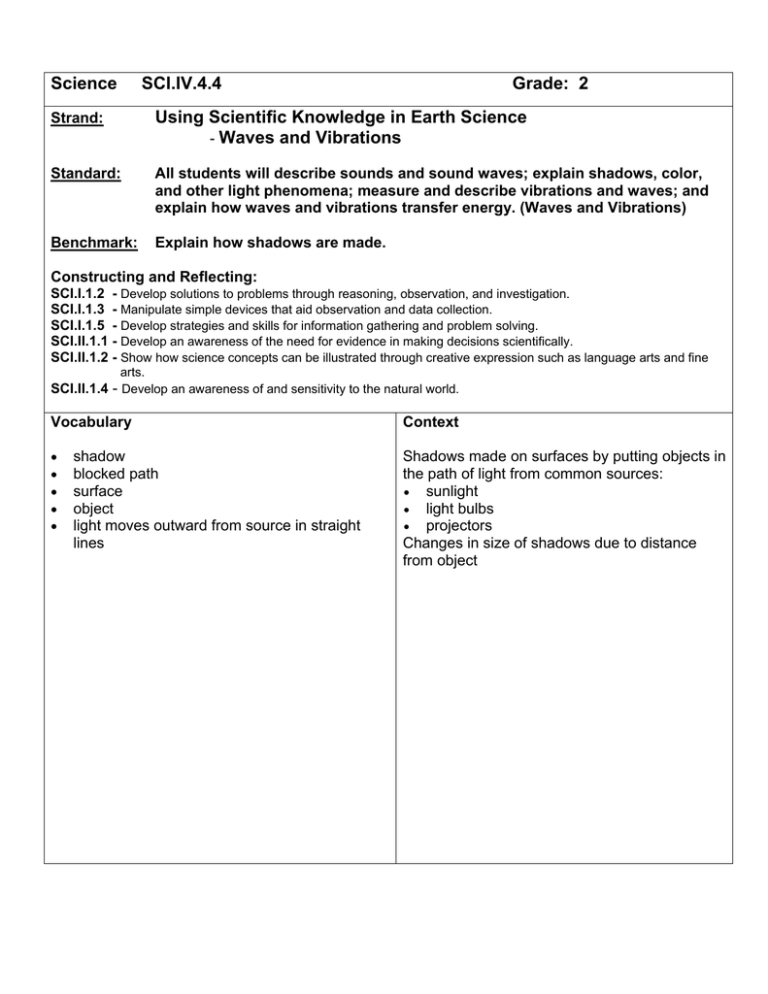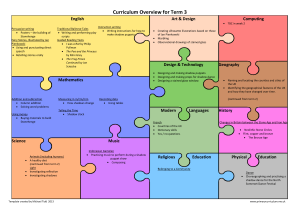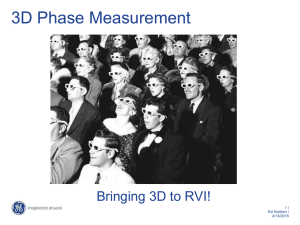Science SCI.IV.4.4 Grade: 2
advertisement

Science SCI.IV.4.4 Grade: 2 Strand: Using Scientific Knowledge in Earth Science - Waves and Vibrations Standard: All students will describe sounds and sound waves; explain shadows, color, and other light phenomena; measure and describe vibrations and waves; and explain how waves and vibrations transfer energy. (Waves and Vibrations) Benchmark: Explain how shadows are made. Constructing and Reflecting: SCI.I.1.2 - Develop solutions to problems through reasoning, observation, and investigation. SCI.I.1.3 - Manipulate simple devices that aid observation and data collection. SCI.I.1.5 - Develop strategies and skills for information gathering and problem solving. SCI.II.1.1 - Develop an awareness of the need for evidence in making decisions scientifically. SCI.II.1.2 - Show how science concepts can be illustrated through creative expression such as language arts and fine arts. SCI.II.1.4 - Develop an awareness of and sensitivity to the natural world. Vocabulary Context • • • • • Shadows made on surfaces by putting objects in the path of light from common sources: • sunlight • light bulbs • projectors Changes in size of shadows due to distance from object shadow blocked path surface object light moves outward from source in straight lines Knowledge and Skills Resources Benchmark Clarification Coloma Resources: Light moves outward from a source in straight lines. When an object blocks the light, a shadow forms. The distance the object is from the light source affects the size of the resulting shadow. Newbridge Science Program – Unit and teacher’s guide Light Students will: • Make a shadow • Explain how a shadow was created Sound and Music Kit - activities Day Light, Night Light – Book Prism Set – (activities & teachers guide) Color Paddles – (activities & teachers guide) Other Resources: Michigan Teacher Network Resources http://mtn.merit.edu/mcf/SCI.IV.4.E.4.html ThinkQuest – Phocus on Physics – EXCELLENT site with activities, interactives and lots of information! http://library.thinkquest.org/J0111285/ ----------------------------------------------------------------- Other Resources (continued from column at right) JCISD – Inquiry Unit on Light and Color http://www.jcisd.org/GeneralEd/math_science/light .doc Zubrowski, Bernie. Shadow Play: Making Pictures With Light & Lenses. BOSTON CHILDREN’S MUSEUM ACTIVITY BOOK. Morrow, 1995. Jacobs, Frank. Fun With Hand Shadows. DOVER GAMES & PUZZLE ACTIVITY BOOKS. Dover, 1996. Primary Physics. AIMS. http://wwws.aimsedu.org/aimscatalog/default.tpl Science NetLinks – Shadows – part of a 4lesson series on the day and night sky. OUTSTANDING – (see V.3.1 for companion lesson) http://www.sciencenetlinks.com/lessons.cfm?Be nchmarkID=11&DocID=10 ProTeacher – lessons and units on light – http://www.proteacher.com/110017.shtml BCISD – Classroom Resources – Physical Science http://www.remc11.k12.mi.us/bcisd/classres/psci ence.htm The Exploratorium – Science Snacks about Light – Awesome, as always! http://www.exploratorium.com/snacks/iconlight.h tml Instruction Benchmark Question: How are shadows made? Assessment Required Assessment Explain how shadows are made Focus Question: How can we create a shadow? Using a light source (flashlight, lamp, overhead projector), students will test various objects to see how to create a shadow. Each student will draw and label a diagram that shows how the shadow is created, The diagram will include the following labels: a light source, straight lines for light energy, a blocked path, and an object and a shadow. Extension: Students can experiment with how changes in distance between a light source and objects affect the size of the shadows. Students can experiment with the angle of the light source to the object and its effects on the length of its shadow. Optional Assessment On a sunny day, students will trace the shadow of an object placed between the Sun and the tracing paper. Each student will write a paragraph that accurately explains how he or she created the shadow. The paragraph will include appropriate terms: a light source, straight lines for light energy, a blocked path, an object and a shadow. (Give students rubric before activity.) Scoring Rubric Criteria: Correctness of Explanation Apprentice - Provides incorrect explanation with many misconceptions and no details. Basic - Provides correct explanation with one misconception and a few details. Meets - Provides correct explanation with some details. Exceeds - Provides correct explanation with many details. Criteria: Use of Terms Apprentice - Uses correctly one or no terms. Basic - Uses correctly two or three terms. Meets - Uses correctly four terms. Exceeds - Uses correctly all five terms Teacher Notes: Explain shadows, color, and other light phenomena. Light and vision are complex phenomena, and it will take many years of study for students to clearly explain what they see in terms of light and its properties. Although young children experience light every day, they need to acquire the concept of light as a form of energy that moves through space. Light is something that is constantly streaming out from light sources in all directions, traveling rapidly through space and bouncing around in "lighted" rooms. Shadows are another concept that is difficult for elementary students to explain without an understanding of light moving through space. Most children notice the similarity between the shape of the object and its shadow. Some students may think of shadows as dark "images" or "reflections" of an object rather than as areas where an object has blocked the light from the light source. As students begin to use the idea of light moving in space to explain shadows they should say, "The shadow was formed because light could not pass through the object." Some middle school students have naïve conceptions. Although most students recognize that light is necessary for vision, they believe its only role is to "light up" the object. Since they can't feel light reaching their eyes, they think their eyes detect objects without anything linking the object to the eye. Once students understand that light travels through space in straight paths, they can use this knowledge to help understand how humans see. They must learn that, in order for them to see non-luminous objects, light must strike the object and then be reflected from the object to their eyes. If the light is completely absorbed by the object, then it cannot be seen. Students should be able to explain how reflected light from an object enters the eye. Students at the middle school level have ideas about reflection that are limited by their perceptions of the effects of light. Most students have daily experiences with mirrors in their homes and rear view mirrors on cars. Their limited understanding of reflection becomes clear when students are asked to compare light shined on a mirror with light shined on a white piece of paper. Students might say, "The light bounces off the mirror, but when the light falls on the paper it stays there." This explanation is directly related to the students' ability to detect the effects of reflection. As students light up something else with the light reflecting off a mirror, they can see that the light has moved from the mirror to another place. With the paper, the only effect they can see is on the paper itself. Students need to understand that light may reflect off ordinary objects. They also need to know that some objects, like mirrors reflect the light in a regular pattern. Other objects, like the white paper, scatter the reflected light, destroying the regular pattern in the light that reaches our eyes. Students encounter colors everywhere they go. They can see colors in a rainbow or in patterns reflected by a soap bubble, yet few children relate these colors to white light. Many students think of white light as being colorless and that colored light is darker than white light. They believe that prisms or bubbles "make" the colored patterns they see. As high school students learn about waves, they discover that white light is actually made of all wavelengths of light mixed together. Students must learn that as white light passes through objects, such as prisms or drops of water, the light is bent. Each wavelength of light is bent differently, separating the light into its different wavelengths or colors. Once students understand that white light is made of a mixture of all colors of light, they can see that color is a property that light already possesses. Nothing needs to be added to white light to give it color. To get colored light from white light, wavelength of other colors must be taken out. Even in high school, students may think color resides in the object, and the only role light plays is to "show" the color. As scientifically literate students move toward the concept that color is a property of light, they can then explain how we see the color of objects. Students should know that the color we see is the color that reaches our eye, because objects reflect some wavelengths of light and absorb others. If an object appears black, it is not reflecting any light; if an object appears white, it is reflecting all wavelengths of light.




